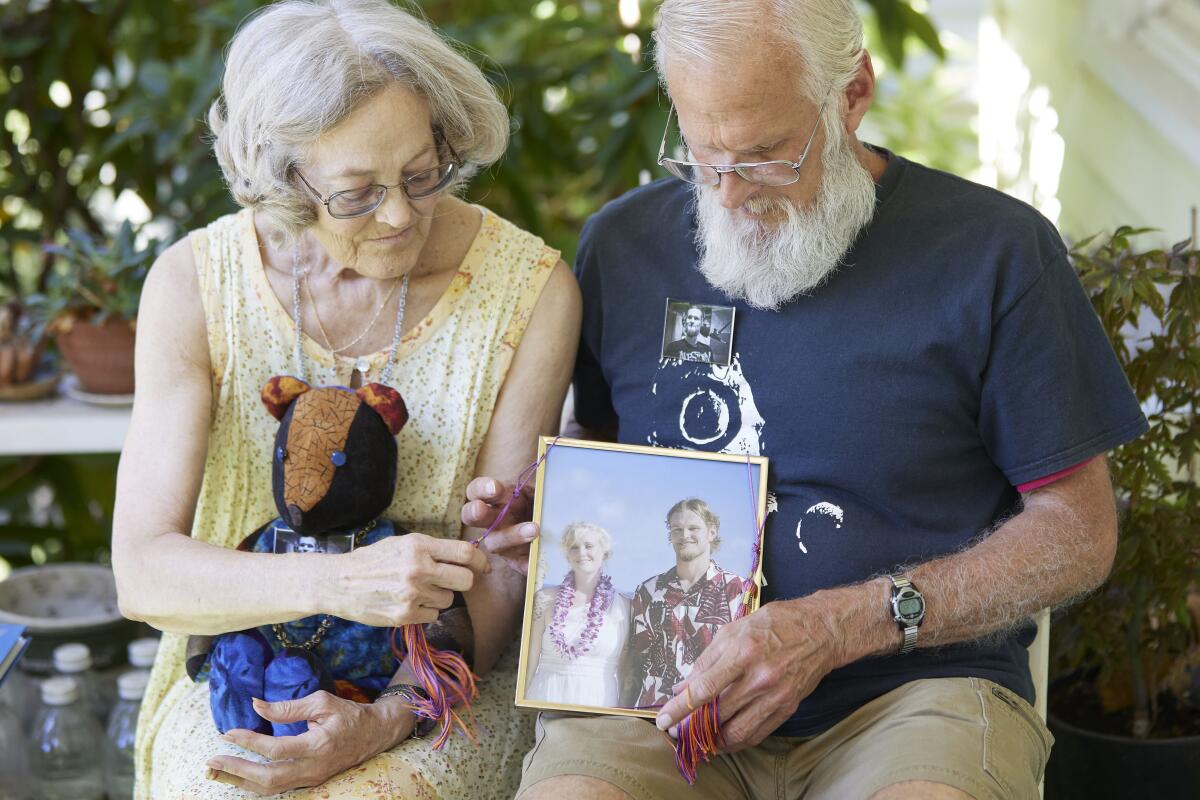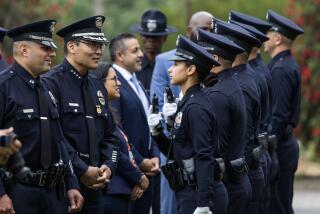Police combat violent crime as ranks dwindle

- Share via
PORTLAND, Ore. — Five years after Brian Spaulding’s parents found him fatally shot in the home he shared with roommates, his slaying remains a mystery that seems increasingly unlikely to be solved as Portland, Ore., police confront a spike in killings and more than 100 officer vacancies.
The detective assigned to investigate the death of Spaulding — a chiropractic assistant who didn’t do drugs, wasn’t in a gang and lived close to the house where he was born — left in 2020 in a wave of retirements and the detective assigned to it now is swamped with fresh cases after Portland’s homicide rate surged 207% since 2019.
“To us, it’s not a cold case,” said George Spaulding, who has his son’s signature tattooed on his arm. “We’re not dissatisfied with the Police Bureau because I think they’re doing the best they can. They are just overwhelmed. It’s insane.”
From Philadelphia to Portland to Los Angeles, killings and gun violence are rising at the same time officers worn out by the pandemic and disillusioned over the calls to divest from policing that followed George Floyd’s murder are quitting or retiring faster than they can be replaced.
Departments are scrambling to recruit in a tight labor market and also rethinking what services they can provide and what role police should play in their communities. Many have shifted veteran officers to patrol, breaking up specialized teams built over decades in order to keep up with 911 calls.
“We’re getting more calls for service and there are fewer people to answer them,” said Philadelphia Police spokesperson Eric Gripp, whose department has been rotating employees from specialty units for short assignments to increase patrols. “This isn’t just an issue in Philadelphia. Departments all over are down and recruitment has been difficult.”
Los Angeles, which is down more than 650 officers from its pre-pandemic staffing level, shuttered its animal cruelty unit; downsized its human trafficking, narcotics and gun details; reduced its homeless outreach teams by 80%. Seattle recently announced $2 million in hiring bonuses and benefits to lure recruits amid a critical officer shortage that has hampered the investigation of serious crimes.
The pinch has led some cities to experiment to reduce strain on patrol officers.
Portland recently added unarmed “public support specialists” to take reports on things like vehicle break-ins and bike thefts, and in San Diego, licensed psychiatric clinicians go to mental health calls with officers.
“For me, I wonder what the profession is going to be 20 years from now if we’re having these challenges on a nationwide scale. Are we going to be able to recruit enough people to serve our cities?” asked Portland Police Chief Chuck Lovell, whose force has lost 237 sworn officers through retirements or resignations since 2020.
Portland logged a record 89 homicides last year — roughly three times its historical average — and is on pace to top that this year after already tallying more than 50. A report completed for the city last month by the California Partnership for Safe Communities found it had the largest homicide rate increase among similarly sized cities and 75% of homicides in 2020 were by gun. The city has seen nearly 800 shootings this year.
That follows a national trend. While nonviolent crime decreased during the pandemic, the murder rate increased nearly 30% in 2020 and the rate of assaults went up 10%, according to the Brennan Center for Justice.
It’s unclear what’s driving the surge, but COVID-19 created huge social disruption and upended government and community support systems. Gun sales also spiked during the pandemic.
Experts say widely cited theories that violent crime is worse in places that changed policing tactics in the wake of protests over Floyd’s murder don’t bear out. Violent crime has increased in red and blue communities alike, regardless of their approach.
“The problem is you see cities where they didn’t do any of those things where crime also went up and you’ll see rural areas where crime also went up as well,” said Ben Struhl, executive director of the Crime and Justice Policy Lab at the University of Pennsylvania.
“There’s a lot of evidence that something bigger is going on than the social justice protests that happened, and it’s probably more than one thing,” said Struhl, whose center has worked with Baltimore, Philadelphia and Oakland to reduce gun violence.
In Portland, gun violence once largely limited to historically marginalized neighborhoods has spread to the downtown core and more affluent areas. Last month, an Uber driver was seriously wounded and his passenger killed in an unsolved shooting.
Jeremiah King, who is transitioning out of homelessness, was shot while trying to protect a friend who was being attacked just a short walk from the city’s business district.
“He turned around and pulled a pistol out and I didn’t see it. I didn’t feel anything at first but 10 seconds later I could hardly breathe,” King said as he sat on a street after three nights in the hospital. “I thought I was going to pass away.”
After King’s shooting, three more people were injured and two killed by gunfire in the same area over a four-day span.
To address the violence, Portland’s police chief broke up specialized units to bolster patrol numbers and moved detectives from assault, cold case and gun violence units to create a third eight-person homicide squad. That effectively stopped investigations into about 300 unsolved slayings going back decades, although Lovell says those investigations will resume when staffing levels return.
Still, Brian Spaulding’s parents now must consider the possibility that one day no one will be assigned to his case. Their son, who would be 41 now, was a free spirit whose interests included jiu jitsu, home-brewed beer and heavy metal — although he also was a sustaining member of the local classical radio station.
Brian’s mother sees a twisted silver lining in the violence on Portland’s streets.
“I keep thinking that with all of the gun violence that’s going on, they might be able to get a gun that matches the gun that killed Brian,” said Carolyn Spaulding, as she clutched a teddy bear made of scraps from his high school graduation quilt.
That gun violence has also spread outside Portland, to the suburban city of Gresham, Ore.
Gresham Police Chief Travis Gullberg has seen 16 officers leave in his 10 months on the job and all of his detectives are handling homicide investigations as gun violence soars.
Conversations around police reform are “important work and it’s an opportunity for us to better serve our community … but that said, as you transition to any of those new programs — which takes a while sometimes — you still have to be providing the basic services,” Gullberg said.
For now, eight officers patrol a city of 115,000 people on a typical evening shift and must constantly make decisions about how to deploy limited resources.
On a recent night, Sgt. Travis Garrison spotted a car with no plates driving erratically. The driver appeared high, probably on methamphetamine, and the passenger was almost comatose, with bloody track marks on his arm.
The driver had a suspended license, but the vehicle wasn’t stolen and no one had an outstanding warrant. Garrison warned the driver to leave the car and find a ride home, and then headed to his next call. It would have taken hours to complete the testing necessary to prove the driver’s meth use, Garrison said, and with officers depleted, the traffic stop wasn’t a priority.
“Right now, because of the spike in violent crime, we’re only able to investigate murders,” child abuse and sex crimes, he said. “We’re triaging.”
But what law enforcement says is a staffing crisis could actually be a case of misdirected resources, said Christy Lopez, co-director of Georgetown Law School’s Center for Innovations in Community Safety.
And in some departments, police have sworn in new recruits this year, although the numbers aren’t keeping up with attrition, they say.
“You really can’t take it at face value when a department says you need more police officers. You need to look at a staffing audit: ‘What are your police officers doing? What are they unable to do?’ It might mean that you actually need another Boys & Girls Club, not more officers,” she said.
Understaffed departments sometimes shift detectives to patrol because of political pressure, but research shows solving violent crime depresses crime rates more effectively than putting rank-and-file officers on the street, Lopez said.
“There may be some places where we need more police, but I’m fairly convinced from the evidence that I’ve seen over the decades that that can’t be the answer everywhere.”
Some have celebrated the downsizing, including homeless advocates in Los Angeles, where 4 out of 5 homeless outreach teams were disbanded.
“Police should be nowhere around outreach. You can’t be the provider of services as well as the jailer,” said Pete White, the founder and executive director of the Los Angeles Community Action Network. “My hope ... is that those resources that go to the Police Department are actually pointed towards real solutions.”
Still many others are fed up with a perceived lack of action by police.
In Philadelphia, where the department is down 550 officers from pre-pandemic staffing and 860 more are on medical leave or restricted duty, City Councilwoman Maria Quiñones-Sánchez said there are more than 30,000 complaints about abandoned cars awaiting police action. One of the worst areas is in her district, where the cars block sidewalks and make the narrower streets impassable.
Officers normally assigned to a unit dealing with neighborhood issues have been shifted to the city center and violent hot spots around Philadelphia, where the homicide rate reached a record high last year.
The abandoned cars bring “trash in the areas, then you know other crimes, quality of life issues, drug dealing, shootings, killings,” said Kimberly Washington, executive director of the Frankford Community Development Corp. “This starts to look like the place where this can all go down because no one cares.”
Royal Harris knows what that’s like.
Growing up in Portland’s gang territory in the 1990s, his brother, two first cousins, two second cousins and numerous friends were shot to death — and many of those cases remain unsolved.
Harris supports the temporary shutdown of the city’s cold case unit if it means police can close fresh cases, even though it takes resources from solving his own loved ones’ slayings.
“Under the current climate, somebody’s going to feel cheated and we have to be honest with that. The question is, who do we cheat?” he said. “These hard decisions [have] to be made to stop this.”
Lauer reported from Philadelphia and Dazio from Los Angeles. AP video journalist Eugene Garcia in Los Angeles contributed to this report.
More to Read
Sign up for Essential California
The most important California stories and recommendations in your inbox every morning.
You may occasionally receive promotional content from the Los Angeles Times.










